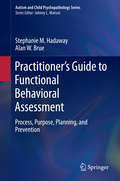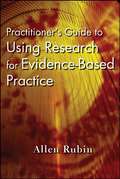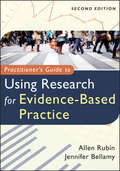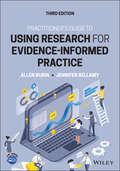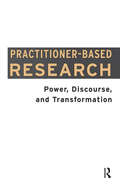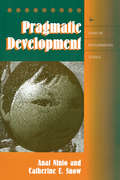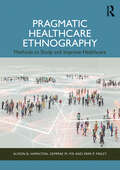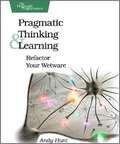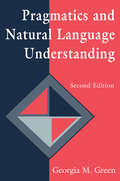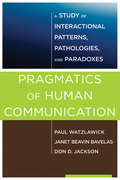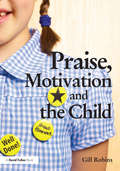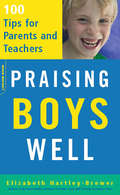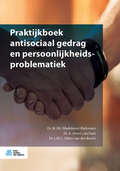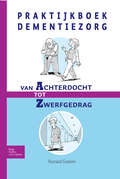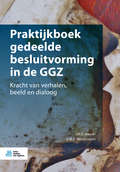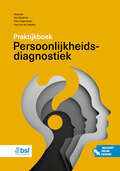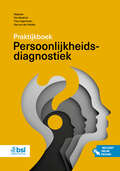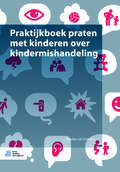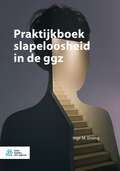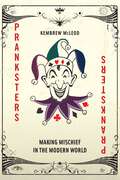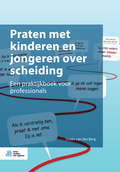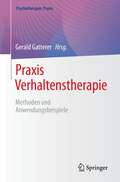- Table View
- List View
Practitioner's Guide to Functional Behavioral Assessment
by Alan W. Brue Stephanie M. HadawayThis practical guide introduces functional behavioral assessment as a critical tool in planning interventions to reduce disruptive and other problematic behaviors. The book offers proven methods and strategies as a four-stage protocol in an easy-to-follow format with checklists, Q&A sections, applications, and an extended case example including an assessment report and intervention plan. Step-by-step instructions are delivered in an accessible teaching style, making all phases of assessment equally manageable. And although functional behavioral assessment is typically associated with schoolchildren, this material is also useful for working with adults in residential and community settings. The Guide gives readers: The basics of functional behavioral assessment. Guidance in preparing for conducting a functional behavioral assessment. An overview of assessment methods: formal and informal measures, interview, and observation. A framework for translating assessment data into an appropriate intervention plan. In-depth understanding of the role of prevention in behavioral intervention. A kit of questionnaires, worksheets, and other ready-to-use resources. Practitioner's Guide to Functional Behavioral Assessment is an essential resource for clinicians and related professionals as well as researchers and graduate students in school and clinical child psychology; behavior therapy; assessment, testing and evaluation; special education; and educational psychology.
Practitioner's Guide to Using Research for Evidence-Based Practice
by Allen RubinWritten by a top scholar in the field, Practitioner's Guide to Using Research for Evidence-Based Practice gives essential and practical guidance on how to integrate research appraisal into evidence-based practice endeavors to ensure the best client care. This reader-friendly book presents you with the knowledge you need about various research designs and methods so that when engaging in the evidence-based practice (EBP) process, you can determine which interventions, programs, policies, and assessment tools are supported by the best evidence.
Practitioner's Guide to Using Research for Evidence-Based Practice
by Allen Rubin Jennifer BellamyPraise for the previous edition "An extraordinary and important book. Its approach to evidence-based practice (EBP) is very sound, realistic, and generous to the complexities of everyday practice. Reading and using this book is a must." —Haluk Soydan, PhD, School of Social Work, University of Southern California "This book has the potential to change practice in the helping professions. Rather than focusing on how to conduct research, Practitioner's Guide to Using Research for Evidence-Based Practice instead shows readers how to understand the literature.... [The] generous use of humor and the inclusion of simple, practice-relevant examples make this book a pleasure to read." —Aron Shlonsky, PhD, Faculty of Social Work, University of Toronto "I particularly like the integration of research methods and EBP; this is the book's major innovation in my mind as it allows readers to see the connections between research and practice. [The book] also succeeds by taking very complex EBP principles and explaining them in practical terms." —Jeffrey M. Jenson, PhD, Graduate School of Social Work, University of Denver Hands-on guidance for research-informed practice and practice-informed research Now in a second edition, Practitioner's Guide to Using Research for Evidence-Based Practice offers a clinician-oriented approach to appraising and using research as part of the EBP process. This accessible guide presents essential and practical guidance on how to integrate research appraisal into EBP endeavors to determine which interventions, policies, and assessment tools are supported by the best evidence. It introduces: Increased attention to macro-level EBP questions and studies New discussion on defining EBP, including the addition of a transdisciplinary model of EBP More detailed guidance on EBP question formulation and conducting Internet searches, including the PICO framework New content on multivariate designs, including propensity score matching, and on mixed-model and mixed-methods studies
Practitioner's Guide to Using Research for Evidence-Informed Practice
by Allen Rubin Jennifer BellamyThe latest edition of an essential text to help students and practitioners distinguish between research studies that should and should not influence practice decisions Now in its third edition, Practitioner's Guide to Using Research for Evidence-Informed Practice delivers an essential and practical guide to integrating research appraisal into evidence-informed practice. The book walks you through the skills, knowledge, and strategies you can use to identify significant strengths and limitations in research. The ability to appraise the veracity and validity of research will improve your service provision and practice decisions. By teaching you to be a critical consumer of modern research, this book helps you avoid treatments based on fatally flawed research and methodologies. Practitioner's Guide to Using Research for Evidence-Informed Practice, Third Edition offers: An extensive introduction to evidence-informed practice, including explorations of unethical research and discussions of social justice in the context of evidence-informed practice. Explanations of how to appraise studies on intervention efficacy, including the criteria for inferring effectiveness and critically examining experiments. Discussions of how to critically appraise studies for alternative evidence-informed practice questions, including nonexperimental quantitative studies and qualitative studies. A comprehensive and authoritative blueprint for critically assessing research studies, interventions, programs, policies, and assessment tools, Practitioner's Guide to Using Research for Evidence-Informed Practice belongs in the bookshelves of students and practitioners of the social sciences.
Practitioner-Based Research: Power, Discourse and Transformation
by Dawn Freshwater John LeesPractitioner-Based Research is concerned, in particular, with the research which is undertaken by healthcare practitioners and the evidence which they generate as a result of investigating their practice. In so doing it recognizes that, as well as working in academic life, practitioner researchers are often working as practitioners outside the Academy. It argues that the work of practitioner researchers has a significant contribution to make to healthcare research and so needs to be disseminated further in order to create balanced research communities within the healthcare professions. This book will help academic researchers to broaden the limited ontological and epistemological perspectives of their research. It will also encourage healthcare practitioners who have not been trained academically to develop their research skills and to realize that they are actually researching in their practice on a day-to-day basis. Finally, it will provide a degree of transparency about therapeutic processes to help clients and patients to see aspects of professional practice and development which are usually hidden from them.
Pragmatic Development
by Anat NinioThe pragmatic system consists of the rules for appropriate and communicatively-effective language use. This book provides an integrated view of the acquisition of the various pragmatic subsystems, including expression of communicative intents, participation in conversation, and production of extended discourse. The three components of the pragmatic system are presented in a way that makes clear how they relate to each other and why they all fall under the rubric of "pragmatics". The authors combine their own extensive work in these three domains with an overview of the field of pragmatic development, describing how linguistic pragmatics relates to other aspects of language development, to social development, and to becoming a member of one's culture.
Pragmatic Healthcare Ethnography: Methods to Study and Improve Healthcare
by Erin P. Finley Alison B. Hamilton Gemmae M. FixThis practical and accessible textbook provides an overview of the key principles for conducting ethnography in healthcare settings. Shedding new light on healthcare delivery and experiences, ethnographic research methods provide a useful set of tools for observing how people act in the world and help us understand why people act as they do. Increasingly recognized for their explanatory power, especially around behavior and social context, ethnographic methods are an invaluable approach for understanding challenges and processes in healthcare services and delivery.This guide takes the reader step-by-step through the research process, from grant writing and study design to data collection and analysis. Each chapter, illustrated by a range of examples, introduces ethnographic concepts and techniques, considers how to apply them in pragmatic research, and includes suggestions for tips and tricks. An in-depth case study describing real-world ethnographic research in a healthcare setting follows each chapter to demonstrate both the “how to” and the value of ethnographic approaches. The case studies discuss why the researcher used ethnography, the specific approach taken, the setting for the work, and key lessons that demonstrate ethnographic principles covered in the related chapter.This is an essential text for researchers from a range of health-related backgrounds new to ethnographic methods, including students taking courses on qualitative research methods in health, implementation science, and applied anthropology.
Pragmatic Thinking and Learning: Refactor Your "Wetware"
by Andy HuntThis book guides us on how to: Use the Dreyfus Model of Skill Acquisition to become more expert; Leverage the architecture of the brain to strengthen different thinking modes; Avoid common "known bugs" in your mind; Learn more deliberately and more effectively; and Manage knowledge more efficiently.
Pragmatics and Natural Language Understanding (Tutorial Essays in Cognitive Science Series)
by Georgia M. GreenThis book differs from other introductions to pragmatics in approaching the problems of interpreting language use in terms of interpersonal modelling of beliefs and intentions. It is intended to make issues involved in language understanding, such as speech, text, and discourse, accessible to the widest group possible -- not just specialists in linguistics or communication theorists -- but all scholars and researchers whose enterprises depend on having a useful model of how communicative agents understand utterances and expect their own utterances to be understood. Based on feedback from readers over the past seven years, explanations in every chapter have been improved and updated in this thoroughly revised version of the original text published in 1989. The most extensive revisions concern the relevance of technical notions of mutual and normal belief, and the futility of using the notion 'null context' to describe meaning. In addition, the discussion of implicature now includes an extended explication of "Grice's Cooperative Principle" which attempts to put it in the context of his theory of meaning and rationality, and to preclude misinterpretations which it has suffered over the past 20 years. The revised chapter exploits the notion of normal belief to improve the account of conversational implicature.
Pragmatics of Human Communication: A Study of Interactional Patterns, Pathologies and Paradoxes
by Don D. Jackson Paul Watzlawick Janet Beavin BavelasThe properties and function of human communication. Called "one of the best books ever about human communication," and a perennial bestseller, Pragmatics of Human Communication has formed the foundation of much contemporary research into interpersonal communication, in addition to laying the groundwork for context-based approaches to psychotherapy. The authors present the simple but radical idea that problems in life often arise from issues of communication, rather than from deep psychological disorders, reinforcing their conceptual explorations with case studies and well-known literary examples. Written with humor and for a variety of readers, this book identifies simple properties and axioms of human communication and demonstrates how all communications are actually a function of their contexts. Topics covered in this wide-ranging book include: the origins of communication; the idea that all behavior is communication; meta-communication; the properties of an open system; the family as a system of communication; the nature of paradox in psychotherapy; existentialism and human communication.
Praise, Motivation and the Child
by Gill RobinsAnyone who spends time with children knows that praise works. It is a powerful motivator - praising children for good behaviour or good work builds self- esteem and self-confidence. Children love to collect stickers, certificates and rewards – so what better way is there to shape behaviour, encourage good work habits and produce confident learners? Teachers and parents alike know that praise is effective – we use it every day and we see the positive effect that it has on our children. However, constructivist practitioners would argue that praise in any form creates hierarchies and competition in the classroom, has little effect on genuine learning and is invasively judgemental rather than supportive. Constructivists would further argue that self-esteem cannot be built by external agency – teachers and parents can only create an appropriate environment in which a robust sense of ‘self’ can grow and develop. This book challenges traditional, embedded thinking about the role of praise. It questions the assumptions we make about developing self-esteem, about the ability of children to form their own independent judgements and the choices that children make regardless, rather than because of, contingent praise. What happens when children are praised? Read this book, listen to what children really think and challenge your own assumptions. Features include: Case studies and children’s work samples; Points for reflection which could be used for CPD sessions; Appendices containing behaviour policy samples; Pupil, teacher and parental perspectives. This book is aimed at practising and training Primary school teachers. It would also be suitable for NQTs who are starting to shape their own practice, experienced teachers who want to develop and question their own practice and students on BA Hons and PGCE courses.
Praising Boys Well: 100 Tips for Parents and Teachers
by Elizabeth Hartley-BrewerBoys need encouragement and praise to develop healthy self esteem, but they can also feel swamped and suffocated by what they see as constant commentary on their every move-and as a result they can be inclined to act out. How can parents strike the right balance between giving effective praise and not going overboard? How can we help our boys to feel proud without inspiring a false sense of confidence or making them praise dependent? Praising Boys Well shows parents and teachers alike what boys need to hear along the developmental continuum and offers countless tips on what to encourage; which phrases to use-and to avoid; when incentives are appropriate; and how to incorporate praise into our boys' everyday activities.
Praktijkboek antisociaal gedrag en persoonlijkheidsproblematiek
by M. J. N. Madeleine Rijckmans A. Arno Van Dam L. M. C. Wies Van Den BoschBehandelaren in de GGZ worden in toenemende mate geconfronteerd met mensen met antisociale problematiek. Dit praktijkboek geeft handvatten voor de behandeling van mensen met antisociaal gedrag voortkomend uit persoonlijkheidsproblematiek. De handvatten zijn gebaseerd op wetenschappelijke kennis en best practices. Het boek is bedoeld voor psychologen, psychiaters, maatschappelijk werkenden en (sociaalpsychiatrisch) verpleegkundigen werkzaam binnen de reguliere en forensische GGZ. Praktijkboek antisociaal gedrag en persoonlijkheidsproblematiek laat aan de hand van praktijkvoorbeelden zien hoe de behandelaar kan omgaan met specifieke behandelsituaties en hulpvragen als agressie, middelengebruik en suïcidaliteit. Daarnaast beschrijft het boek methodes om cliënten en hun sociale omgeving te helpen het antisociale gedrag te veranderen of er beter mee om te gaan. Ook wordt er aandacht besteed aan de emoties die deze cliënten oproepen bij behandelaren en aan de vraag hoe behandelaren hier effectief mee om kunnen gaan. Het eerste deel beschrijft argumenten voor en tegen het behandelen van mensen met antisociaal gedrag of antisociale persoonlijkheidsproblematiek. Daarna worden de mogelijkheden van het doen van diagnostiek en risicotaxatie binnen de reguliere GGZ beschreven en wordt stilgestaan bij het belang van de therapeutische relatie. Vervolgens worden theorieën en technieken beschreven om de doelgroep te motiveren voor behandeling. In het tweede deel staan de meer specifieke problematieken van de doelgroep centraal, zoals het voorkomen en behandelen van agressie, omgaan met verslavingsproblematiek en suïcidaliteit. Het derde deel beschrijft specifieke behandelmethodieken, waaronder Dialectische gedragstherapie, de forensische variant van Schemagerichte therapie, Farmacotherapie, Systeemtherapie en een meer outreachende benadering. Praktijkboek antisociaal gedrag en persoonlijkheidsproblematiek is geschreven onder redactie van Dr. Madeleine Rijckmans, Dr. Arno van Dam en Dr. Wies van den Bosch. Zij werken alle drie als behandelaar in de klinische (forensische) praktijk en doen wetenschappelijk onderzoek. Ook zijn ze lid van het internationaal Podium Antisociaal Gedrag van waaruit ze proberen de behandelpraktijk voor deze doelgroep te verbeteren.
Praktijkboek dementiezorg
by R. GeelenDit boek is gericht op de professionele verzorger die dagelijks omgaat met dementerende ouderen. Het beschrijft een uitgebreid scala aan zorgsituaties en aandachtsgebieden in stemming en gedrag (van achterdocht tot zwerfgedrag) bij de dementerende. Het boek biedt een praktisch stappenplan voor een betere begeleiding van deze ouderen.
Praktijkboek dementiezorg: Van Achterdocht tot Zwerfgedrag
by R. GeelenEen begeleider van bewoners met dementie krijgt te maken met hun uiteenlopende stemmingen en gedragingen. Zoals angstig en agressief gedrag, gevoelens van rouw en dwalen. Dit boek gaat in op deze en andere onderwerpen, en geeft voorbeelden van de mensen die ermee kampen in de vorm van herkenbare portretten. De wisselwerking tussen bewoner en begeleider wordt belicht, waarbij tips volgen om de moeilijkheden in stemming en gedrag te hanteren. Het daarvoor aangereikte stappenplan is een krachtig hulpmiddel bij het opstellen van adviezen en zorgplannen. De schrijftaal is begrijpelijk, de inhoud gebaseerd op veel praktijkervaring.
Praktijkboek eetstoornissen: Achtergrond, diagnostiek en behandeling
by P. J. Daansen E. M. Elske Van Den BergDit praktijkboek helpt behandelaren bij de diagnose en behandeling van eetstoornissen. Het biedt praktische handvatten voor iedere hulpverlener, ervaren of junior, die eetstoornissen tegenkomt in de dagelijkse praktijk. Praktijkboek eetstoornissen: Achtergrond, diagnostiek en behandeling bestaat uit drie delen. De eerste hoofdstukken behandelen een aantal theoretische aspecten, zoals risicofactoren, comorbiditeit en epidemiologie. Daarbij legt het boek steeds een link naar de praktijk. Het tweede deel bespreekt de behandeling van de vier meest voorkomende eetstoornissen: anorexia nervosa, boulimia nervosa, binge eating disorder en ARFID. Centraal staan daarbij de relevante vragen voor het therapeutisch handelen: hoe kom je tot een passende diagnose? Aan welke differentiaaldiagnostiek moet je denken? Voor welk behandelmodel kies je? Het derde deel gaat ten slotte in op specifieke doelgroepen, aan de hand van uitgebreide casuïstiek. Het boek wordt in het vierde deel afgesloten met een concluderend hoofdstuk en enkele aanbevelingen voor de toekomst.
Praktijkboek gedeelde besluitvorming in de GGZ: Kracht van verhalen, beeld en dialoog
by J.M.G. Maurer G.M.A. WestermannDit boek beschrijft hoe efficiënt behandelen binnen de GGZ mogelijk is als hulpvragers en hulpverleners vanuit een gedeelde visie samen beslissen over de te bieden zorg. In dit boek leer je stapsgewijs – van aanmelding tot afronding van de behandeling – hoe je de principes van gedeelde besluitvorming met hulp van het Dialoogmodel kunt toepassen in de praktijk. Efficiënt behandelen in de GGZ vraagt om goed afgestemde samenwerking en voldoende wederzijds vertrouwen. Samen duidelijk krijgen wat speelt, wat nodig is en wie dat op welke manier kan bieden en daarover samen beslissen, daar draait het om. Gedeelde besluitvorming is dus niet alleen de juiste behandelvorm koppelen aan de juiste diagnose. Vanaf aanmelding tot afronding zijn er talloze momenten waarop je als behandelaar – al dan niet bewust – keuzes maakt en beslissingen neemt over je rol, positie, attitude en inbreng. Datzelfde geldt voor hulpvragers. Als deze keuzes en beslissingen goed op elkaar aansluiten, is de kans op een gunstig resultaat het grootst. Zo samen optrekken, biedt alle betrokkenen de meeste voldoening. Het Praktijkboek gedeelde besluitvorming in de GGZ richt zich op het hanteren van dagelijkse praktijksituaties. Deze komen in elk hoofdstuk ruimschoots aan bod, geïllustreerd met afbeeldingen en aangevuld met handige formats. Je leest hoe gedeelde besluitvorming helpt om je kennis en expertise en die van de hulpvrager optimaal te benutten. Het Dialoogmodel wordt hierbij als hulpmiddel ingezet. Dit model verbindt en integreert de visies en verhalen van hulpvragers en betrokken behandelaren via dialoog op basis van een goede werkrelatie. Jac Maurer werkte tot zijn pensionering als klinisch psycholoog/psychotherapeut in de volwassen-, kinder- en jeugdzorg in de GGZ. Daarbij was hij lid van wetenschapscommissies en vervulde hij de rol van P-opleider. George Westermann is kinder- en jeugdpsychiater/psychotherapeut. Daarnaast is hij opleider kinder- en jeugdpsychiatrie en medisch manager bij Zuyderland GGZ. Hij is internationaal wetenschappelijk actief op het gebied van gedeelde besluitvorming.
Praktijkboek persoonlijkheidsdiagnostiek
by Han Berghuis Theo Ingenhoven Paul van der HeijdenDit boek biedt een veelzijdig overzicht van uiteenlopende perspectieven en methodieken van persoonlijkheidsdiagnostiek. De focus ligt hierbij steeds op de toepassing in de klinische praktijk en de reflectie hierop. Het Praktijkboek persoonlijkeidsdiagnostiek brengt vormen van persoonlijkheidsdiagnostiek in beeld vanuit verschillende theoretische referentiekaders en diverse methoden van onderzoek: een multiconceptueel en multimethodisch perspectief. Centraal staat hierbij steeds het gebruik van specifieke methoden of diagnostische instrumenten in de klinische praktijk, ten behoeve van indicatiestelling voor behandeling inclusief de wijze van verslaglegging. Op basis van fundamentele uitgangspunten voor psychodiagnostiek, als essentieel onderdeel van het diagnostische proces, komen telkens veel gebruikte benaderingswijzen van persoonlijkheidsdiagnostiek en diagnostische instrumenten aan de orde. Bovendien wordt uitvoerig stilgestaan bij de differentiaaldiagnostiek met specifieke psychische stoornissen, waarbij ook aandacht is voor overstijgende transdiagnostische factoren. Ten slotte wordt er ingegaan op persoonlijkheidsdiagnostiek bij specifieke doelgroepen en contexten, zoals adolescenten, ouderen, mensen met een licht verstandelijke beperking, en het forensische kader. Ook cultuursensitieve persoonlijkheidsdiagnostiek komt aan de orde. Het boek heeft een praktijkgerichte opbouw, elk hoofdstuk is gericht op de klinische toepassing, met steeds een praktijkcasus als voorbeeld, inclusief een voorstel voor de verslaglegging. Elk hoofdstuk sluit af met een kritische beschouwing over de sterke kanten en de beperkingen van de gekozen invalshoek. De vele voorbeelden in dit praktijkboek zijn bedoeld als bron van inspiratie voor psychologen, gz-psychologen, psychotherapeuten, klinisch psychologen, psychiaters die uitvoer geven aan persoonlijkheidsdiagnostiek in de klinische praktijk. Bovendien is het boek ook geschikt voor allen die hiertoe in opleiding zijn.
Praktijkboek persoonlijkheidsdiagnostiek
by Han Berghuis Theo Ingenhoven Paul van der HeijdenDit boek biedt een veelzijdig overzicht van uiteenlopende perspectieven en methodieken van persoonlijkheidsdiagnostiek. De focus ligt hierbij steeds op de toepassing in de klinische praktijk en de reflectie hierop. Het Praktijkboek persoonlijkeidsdiagnostiek brengt vormen van persoonlijkheidsdiagnostiek in beeld vanuit verschillende theoretische referentiekaders en diverse methoden van onderzoek: een multiconceptueel en multimethodisch perspectief. Centraal staat hierbij steeds het gebruik van specifieke methoden of diagnostische instrumenten in de klinische praktijk, ten behoeve van indicatiestelling voor behandeling inclusief de wijze van verslaglegging. Op basis van fundamentele uitgangspunten voor psychodiagnostiek, als essentieel onderdeel van het diagnostische proces, komen telkens veel gebruikte benaderingswijzen van persoonlijkheidsdiagnostiek en diagnostische instrumenten aan de orde. Bovendien wordt uitvoerig stilgestaan bij de differentiaaldiagnostiek met specifieke psychische stoornissen, waarbij ook aandacht is voor overstijgende transdiagnostische factoren. Ten slotte wordt er ingegaan op persoonlijkheidsdiagnostiek bij specifieke doelgroepen en contexten, zoals adolescenten, ouderen, mensen met een licht verstandelijke beperking, en het forensische kader. Ook cultuursensitieve persoonlijkheidsdiagnostiek komt aan de orde. Het boek heeft een praktijkgerichte opbouw, elk hoofdstuk is gericht op de klinische toepassing, met steeds een praktijkcasus als voorbeeld, inclusief een voorstel voor de verslaglegging. Elk hoofdstuk sluit af met een kritische beschouwing over de sterke kanten en de beperkingen van de gekozen invalshoek. De vele voorbeelden in dit praktijkboek zijn bedoeld als bron van inspiratie voor psychologen, gz-psychologen, psychotherapeuten, klinisch psychologen, psychiaters die uitvoer geven aan persoonlijkheidsdiagnostiek in de klinische praktijk. Bovendien is het boek ook geschikt voor allen die hiertoe in opleiding zijn.
Praktijkboek praten met kinderen over kindermishandeling
by Marike van GemertKinderen die kindermishandeling meemaken, voelen zich vaak te weinig gezien en gehoord. Dit boek laat zien hoe je ruimte geeft voor hun verhaal en inbreng en geeft daarmee concrete handreikingen om deze kinderen daadwerkelijk centraal te stellen. Het boek richt zich op jeugdhulpverleners en andere professionals die in hun werk te maken krijgen met kinderen in onveilige thuissituaties.Praktijkboek praten met kinderen over kindermishandeling is geschreven in de overtuiging dat je kinderen en gezinnen veel beter kunt helpen als je weet hoe het kind zijn of haar situatie beleeft. Het maakt duidelijk waar hulpverleners rekening mee moeten houden. Wat maakt het opgroeien in onveiligheid complex en wat betekent dat voor gesprekken met deze kinderen? Het boek bespreekt wat de ingrediënten zijn van een goed gesprek en hoe je een vertrouwensband opbouwt met het kind. De vele voorbeelddialogen, citaten van jongvolwassen ervaringsdeskundigen en dilemma’s uit de praktijk maken het boek ook erg toegankelijk voor professionals voor wie deze gesprekken geen dagelijkse kost zijn. Kim: ‘Het gaat er niet om dat iemand ons komt redden, het gaat erom dat iemand mij ziet!’ Marike van Gemert is trainer en deskundige op het gebied van praten met kinderen over kindermishandeling. Vanuit de Academie voor Praten met Kinderen leidt ze professionals hierin op: www.academiepratenmetkinderen.nl
Praktijkboek slapeloosheid in de ggz
by Inge M. EnsingDit boek geeft ggz-professionals inzicht in de samenhang tussen psychische klachten en langdurige slapeloosheid. Daarnaast helpt het hen om slapeloosheid bij cliënten vast te stellen en te behandelen.Praktijkboek slapeloosheid in de ggz biedt kennis over langdurige slapeloosheid en hoe deze meest voorkomende slaapstoornis in relatie staat tot psychische klachten, lichamelijke problemen en het gebruik van middelen en medicatie. Ook biedt het boek een overzicht van andere veelvoorkomende slaap-waakstoornissen. Casuïstiek en illustraties verhelderen de vicieuze cirkel van denken, voelen en doen die slapeloosheid in stand houdt. Alle manieren om deze dynamiek te doorbreken komen aan bod: van cognitieve gedragstherapie en medicatie tot aanvullende psychologische therapieën. Daarnaast geeft het boek adviezen om tot het meest passende behandelplan te komen. Tot slot bevat het aanbevelingen voor een op maat gesneden aanpak voor specifieke cliëntengroepen, zoals mensen met een depressie of ptss.Inge Ensing is gezondheidszorgpsycholoog, gedragstherapeut VGCt© en somnoloog. Zij heeft ervaring met verschillende populaties binnen de ggz en is geschoold in emdr en ACT. Sinds 2018 is zij werkzaam bij het Expertisecentrum Slaap en Psychiatrie van GGZ Drenthe. Daar onderzoekt en behandelt ze met een multidisciplinair team cliënten met slaap-waakstoornissen. Inge geeft regelmatig cursussen en workshops over dit onderwerp.
Pranksters: Making Mischief in the Modern World
by Kembrew McLeodFrom BenjaminFranklin's newspaper hoax that faked the death of his rival to Abbie Hoffman’sattempt to levitate the Pentagon, pranksters, hoaxers, and con artists have causedconfusion, disorder, and laughter in Western society for centuries. Profilingthe most notorious mischief makers from the 1600s to the present day, Prankstersexplores how “pranks” are part of a long tradition of speaking truth to powerand social critique.Invoking such historical and contemporary figures as P.T. Barnum,Jonathan Swift, WITCH, The Yes Men, and Stephen Colbert, Kembrew McLeod showshow staged spectacles that balance the serious and humorous can spark importantpublic conversations. In some instances, tricksters have incited social change(and unfortunate prank blowback) by manipulating various forms of media, fromnewspapers to YouTube. For example, in the 1960s, self-proclaimed “professionalhoaxer” Alan Abel lampooned America’s hypocritical sexual mores by usingconservative rhetoric to fool the news media into covering a satirical organizationthat advocated clothing naked animals. In the 1990s, Sub Pop Recordsthen-receptionist Megan Jasper satirized the commodification of alternativemusic culture by pranking the New YorkTimes into reporting on her fake lexicon of “grunge speak.” Throughout thisbook, McLeod shows how pranks interrupt the daily flow of approved informationand news, using humor to underscore larger, pointed truths.Written in an accessible, story-driven style, Prankstersreveals how mischief makers have left their shocking, entertaining, andeducational mark on modern political and social life.
Praten met kinderen en jongeren over scheiding: Een Praktijkboek Voor De Professional
by Tineke BergDit handboek geeft professionals concrete suggesties over het voeren van gesprekken met kinderen en jongeren van wie de ouders gescheiden zijn. Hulpverleners lezen wat die kinderen te doen staat en krijgen gesprekstechnieken aangereikt om hen daarbij te helpen. Bovendien biedt het boek materiaal voor hulpverleners die ouders begeleiden in het omgaan met hun kind na scheiding. Een aantal hoofdstukken in Praten met kinderen en jongeren over scheiding zijn ingedeeld naar praktische thema’s waar kinderen mee te maken krijgen na een scheiding. Behalve achtergrondinformatie en technieken geeft het boek ideeën voor en praktische voorbeelden van gesprekken voeren en werken met kinderen van verschillende leeftijden.Auteur drs. T.G. van den Berg is senior GZ-psycholoog kind & jeugd en Orthopedagoog-Generalist. Ze ontwikkelde !JES het brugproject, een erkende effectieve jeugdinterventie voor kinderen en ouders na scheiding. Ook traint ze professionals om met deze methodiek te werken. In haar praktijk !JES jij en scheiden werkt zij met kinderen en ouders na scheiding. Van den Berg verzorgt scholing voor scheidingsprofessionals, is Bijzondere Curator bij de rechtbank en geeft aan de Rijksuniversiteit Groningen het blok Ouderschap na scheiden aan studenten Orthopedagogiek-Generalist.
Praxis Körperpsychotherapie: 10 Prinzipien der Arbeit im therapeutischen Prozess (Psychotherapie: Praxis)
by Ulfried GeuterDieses Buch zeigt zehn grundlegende Prinzipien einer erlebenszentrierten Psychotherapie, die Körpererleben, Körperwahrnehmung, Körperausdruck und Körperkommunikation integriert. Es stellt Therapie als eine verkörperte Begegnung vor und vermittelt, wie man den Körper einbezieht und welche Sprache man dazu verwendet – so wird das Konzept des Embodiment in der Praxis nutzbar. Auch geht es um die Bedeutung von Erleben und Erfahren, um die Indikation und Kontraindikation von Techniken, die therapeutische Beziehung und die Wirkprinzipien der Körperpsychotherapie. Geschrieben für Psychologische und Ärztliche Psychotherapeuten, Körper- und Bewegungstherapeuten, Studierende und Interessierte. Aus dem Inhalt: Wahrnehmen und Spüren – Gewahrsein und Gegenwart – Erkunden und Entdecken – Aktivieren und Ausdrücken – Regulieren und Modulieren – Zentrieren und Erden – Berühren und Halten – Inszenieren und Interagieren – Verkörpern und Handeln – Reorganisieren und Transformieren.Der Autor: Prof. Dr. Ulfried Geuter, Psychologischer Psychotherapeut, Lehrtherapeut, Lehranalytiker und Dozent in der psychotherapeutischen Weiterbildung, Ausbildungen in Psychoanalyse und Körperpsychotherapie; niedergelassen in eigener Praxis in Berlin; unterrichtet im Studienschwerpunkt Körperpsychotherapie des Masterstudiengangs Motologie der Universität Marburg. 2015 erschien von ihm ein Grundriss einer Theorie der Körperpsychotherapie, der von der Fachwelt sehr beachtet wurde.
Praxis Verhaltenstherapie: Methoden und Anwendungsbeispiele (Psychotherapie: Praxis)
by Gerald GattererIn diesem Praxisbuch für angehende und ausgebildete Verhaltenstherapeuten, Psychotherapeuten, Psychiater, Psychosomatische Mediziner und Psychologen werden die einzelnen Schritte einer Psychotherapie praxisrelevant dargestellt. Im Mittelpunkt steht die praktische Vermittlung von Techniken und deren Einsatz im therapeutischen Prozess. Neben den Standardverfahren kommen zur Sprache: Achtsamkeit und Akzeptanz, Schematherapie, Dialektisch Behaviorale Therapie und Neuropsychotherapie. Das Werk ist kurz und prägnant gehalten – für den Einsatz in der Lehre und im therapeutischen Prozess. Schwerpunkt: Erwachsenenpsychotherapie. Aus dem Inhalt: Erstgespräch – Diagnostik – Therapeutische Verfahren – Durchführung der Behandlung – Schwierige Therapiesituationen – Therapieende. Der Herausgeber: Univ.-Doz. Dr. Gerald Gatterer, Leiter des Instituts für Alternsforschung an der Sigmund Freud Privatuniversität; stellvertretender Vorsitzender, wissenschaftlicher Leiter und Lehrtherapeut der Arbeitsgemeinschaft für Verhaltenstherapie und Lehrtherapeut und Vortragender an der Sigmund Freud Privatuniversität – Psychotherapiewissenschaft kognitive Verhaltenstherapie, der Donauuniversität Krems und verschiedenen Fachhochschulen; Psychotherapeut in freier Praxis.
